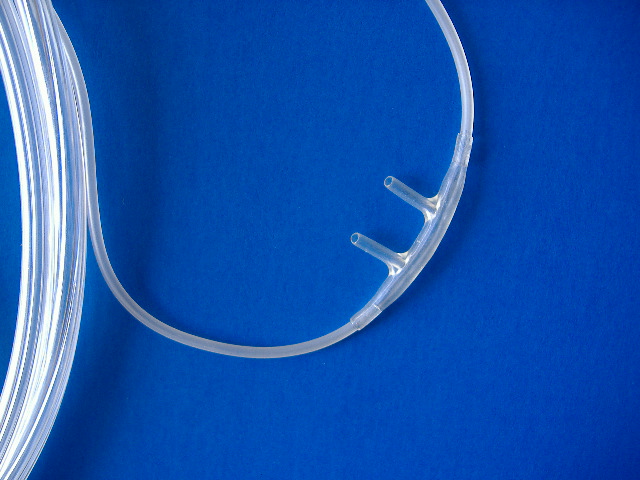

The nasal cannula (NC) is a device used to deliver supplemental oxygen or airflow to a patient or person in need of respiratory help. This device consists of a plastic tube which fits behind the ears, and a set of two prongs which are placed in the nostrils. Oxygen flows from these prongs.[1] The nasal cannula is connected to an oxygen tank, a portable oxygen generator, or a wall connection in a hospital via a flowmeter. The nasal cannula carries 1–6 litres of oxygen per minute. There are also infant or neonatal nasal cannulas which carry less than one litre per minute; these also have smaller prongs. The oxygen fraction provided to the patient ranges roughly from 24% to 35%, or the cannula may merely supply humidified air.
The nasal cannula was invented by Wilfred Jones and patented in 1949 by his employer, BOC.
Supplemental oxygen
A nasal cannula is generally used wherever small amounts of supplemental oxygen are required, without rigid control of respiration, such as in oxygen therapy. Most cannulas can only provide oxygen at low flow rates—up to 6 litres per minute (L/min)—delivering an oxygen concentration of 28–44%. Rates above 6 L/min can result in discomfort to the patient, drying of the nasal passages, and possibly nose bleeds (epistaxis).
The nasal cannula is often used in elderly patients or patients who can benefit from oxygen therapy but do not require it to self respirate. These patients do not need oxygen to the degree of wearing a non-rebreather mask. It is especially useful in those patients where vasoconstriction could negatively impact their condition, such as those suffering from strokes. It may also be used by pilots and passengers in small, unpressurized aircraft that do not exceed certain altitudes. The cannula provides extra oxygen to compensate for the lower oxygen content available for breathing at the low ambient air pressures of high altitude, preventing hypoxia. Special aviation cannula systems are manufactured for this purpose.
[edit]Nasal high flow
High flows of an air/oxygen blend can be administered via a nasal cannula to accurately deliver high concentrations of oxygen.[2] Respiratory gas humidification allows the high flows to be delivered comfortably via the cannula.[3] Nasal high flow can be used as an alternative to face mask oxygen and allows the patient to continue to talk, eat and drink while receiving the therapy.[4]
References
- ^ Image of nasal cannula from Glasgow Rescue Squad
- ^ Sim, DA; Dean, P; Kinsella, J; Black, R; Carter, R; Hughes, M (September 2008). "Performance of oxygen delivery devices when the breathing pattern of respiratory failure is simulated.". Anaesthesia 62 (9): 938–40. PMID 18540928.
- ^ Turnbull, B (2008). "High-flow humidified oxygen therapy used to alleviate respiratory distress". British Journal of Nursing (Mark Allen) 17 (19): 1226–30. PMID 18974691.
- ^ Tiruvoipati, Ravindranath; Lewis, David; Haji, Kavi; Botha, John (September 2009). Journal of Critical Care (World Federation of Societies of Intensive and Critical Care Medicine). doi:10.1016/j.jcrc.2009.06.050. PMID 19781896


1 comments:
Posting Komentar